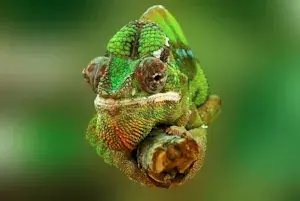Hatching and Incubating Panther Chameleon Eggs: A Guide for Breeders
Panther chameleons (Furcifer pardalis) are popular terrarium animals, known for their vibrant colors and fascinating behaviors. However, breeding them requires expertise and patience – especially when it comes to hatching the eggs. In this article, you will receive a comprehensive guide to incubating Panther chameleon eggs, from egg-laying to the hatching of the young.
1. Requirements for Breeding Panther Chameleons
Sexual Maturity and Mating
- Sexual Maturity: Females reach sexual maturity at around 10–12 months, while males reach it slightly earlier.
- Mating: After mating, it typically takes about 20–30 days for the female to lay her eggs.
Preparing the Female
- Feeding: A protein-rich diet supplemented with calcium will strengthen the female during egg-laying.
- Egg-Laying Site: Provide the female with a loose layer of sand or a mixture of sand and soil (about 20–30 cm deep) where she can lay her eggs.
2. Egg-Laying and Egg Collection
Recognizing Egg-Laying Readiness
- A gravid female often shows signs of restlessness, such as digging in the substrate.
- Just before laying, the female may refuse food.
Egg-Laying Process
- Typically, the female lays 20–40 eggs in a hole, which she then covers.
- Gently remove the eggs from the laying site, without turning them, as the orientation of the embryo inside the eggshell is important.
Storage until Incubation
- Place the eggs in a shallow box with moist vermiculite until they can be transferred to the incubator.
3. Preparing the Incubator
Suitable Incubator
- A reptile incubator or a modified poultry incubator works well.
- Ensure the incubator maintains a constant temperature and humidity.
Incubation Medium
- Use a moist substrate like vermiculite or perlite in a 1:1 ratio (water to substrate by weight).
- The medium should be moist but not soaking wet – press out excess water before placing the eggs.
Arranging the Eggs
- Space the eggs sufficiently to allow proper air circulation.
- Mark the top of each egg to prevent accidental turning.
4. Incubation of the Eggs
Temperature and Humidity
- Temperature: Maintain a consistent temperature between 26–28 °C. Fluctuations can harm the hatching success.
- Humidity: The humidity should be kept at 70–80%. Regularly check the incubation medium and add water if necessary.
Embryo Development
- Panther chameleon eggs typically require 6–12 months to hatch, depending on the temperature.
- During this period, the eggs will slightly change in color and shape, indicating embryo development.
Regular Checks
- Inspect the eggs weekly for mold or other anomalies. Immediately remove any dead or moldy eggs.
- Avoid unnecessary opening of the incubator to minimize temperature fluctuations.
5. Hatching the Young
Signs of Hatching
- Just before hatching, the eggs will become plumper, and the young will begin to break the eggshell using a special “egg tooth”.
- The hatching process may take several hours.
After Hatching
- Allow the young to remain in the incubator for a few hours so they can fully detach from the eggshell.
- Then, transfer them to a prepared rearing terrarium.
6. Rearing the Young
Setting Up the Rearing Terrarium
- Temperature: Maintain the temperature at 26–28 °C during the day, and 20–22 °C at night.
- Lighting: UVB lighting is crucial for the health of the young chameleons.
- Setup: Provide small branches and plants for climbing opportunities.
Feeding the Young
- Feed newly hatched chameleons small insects such as fruit flies or tiny crickets.
- Supplement their diet with calcium and vitamin supplements.
7. Common Problems and Solutions
Mold Growth on Eggs
- Problem: Mold can spread quickly and threaten other eggs.
- Solution: Ensure the substrate is not too wet and remove affected eggs immediately.
Temperature Fluctuations
- Problem: Fluctuating temperatures can impair embryo development.
- Solution: Use a reliable incubator with temperature regulation.
Deformed or Infertile Eggs
- Problem: Some eggs may not develop, either due to insufficient fertilization or other factors.
- Solution: Remove these eggs early to optimize the environment for the remaining eggs.
8. Tips for Successful Incubation
- Document the incubation process for future reference.
- Research thoroughly in advance to ensure you have sufficient space for the young.
- Exercise patience: Panther chameleons are sensitive animals, and the hatching success relies heavily on consistent care.
9. Conclusion
Hatching and incubating Panther chameleon eggs is a challenging but rewarding process. With the right preparation, suitable conditions, and regular monitoring, you can successfully breed healthy young chameleons and contribute to the preservation of these fascinating creatures.

